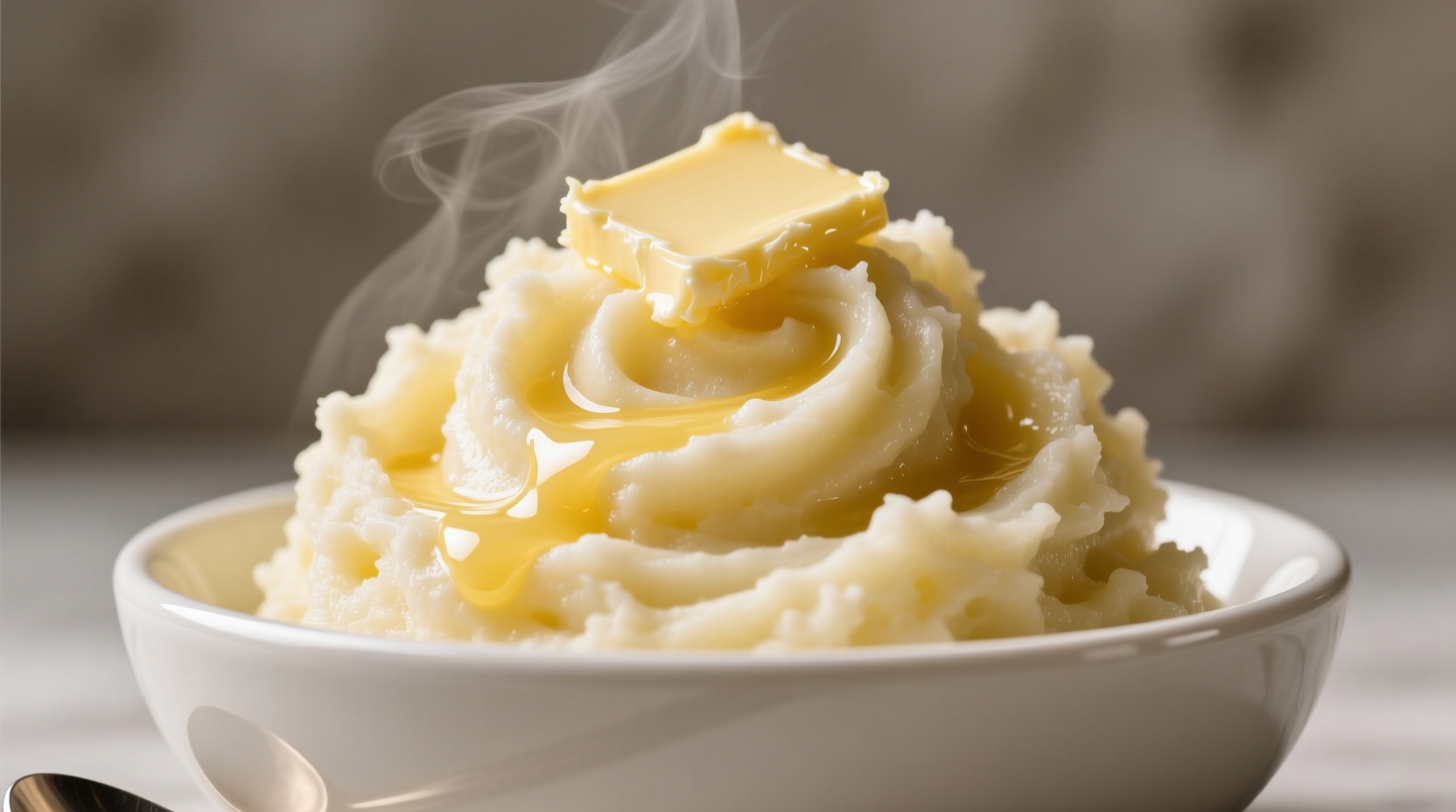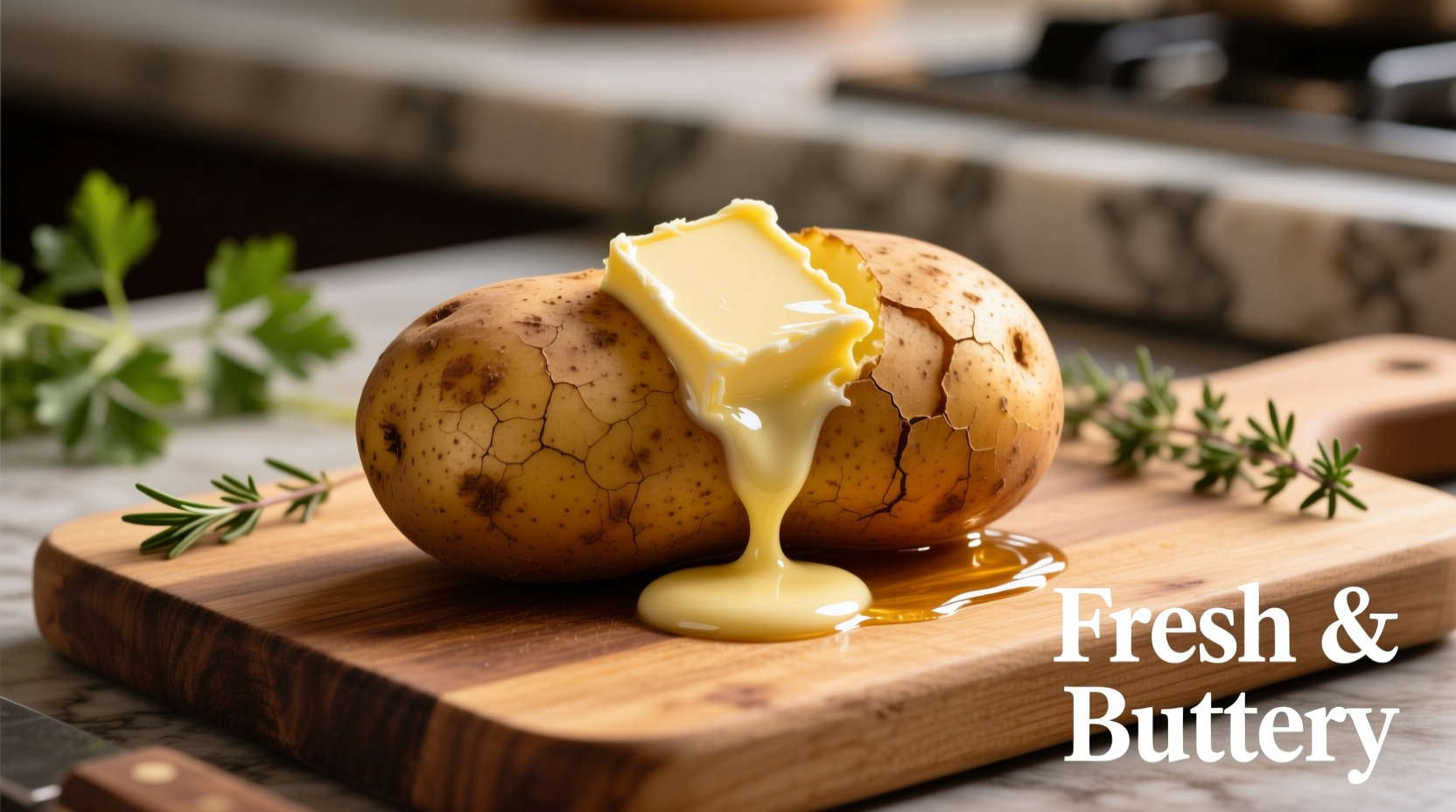There's a reason this humble combination has stood the test of time across cultures. When prepared correctly, potatoes with butter transform from a simple side dish into a culinary experience that highlights how two basic ingredients can create something extraordinary through proper technique and understanding of their chemical interaction.
The Science Behind the Perfect Pairing
Understanding why potatoes and butter work so well together begins with food chemistry. Potatoes contain starch granules that absorb water when cooked, creating that familiar fluffy texture. When butter—composed of 80% fat, 15-18% water, and 1-2% milk solids—is added to properly cooked potatoes, the fat molecules coat the starch granules, creating a smooth mouthfeel while preventing the potatoes from becoming gluey.
| Potato Variety | Starch Content | Best Butter Application |
|---|---|---|
| Russet | High (20-22%) | Fold in after draining for fluffy texture |
| Yukon Gold | Medium (16-18%) | Whip with warm butter for creamy consistency |
| Red Bliss | Low (14-16%) | Toss with melted butter while warm for salad applications |
This information comes from the USDA Agricultural Research Service which has documented the precise starch composition of common potato varieties. The optimal starch-to-fat ratio creates that satisfying mouthfeel that makes this simple dish so universally appealing.
Selecting Your Foundation: Potato Varieties
Not all potatoes behave the same when paired with butter. Your choice determines whether you'll achieve fluffy mashed perfection, creamy texture, or firm bite for salads:
- Starchy potatoes (Russets, Idahos): Ideal for fluffy mashed preparations. Their high starch content absorbs butter beautifully but requires careful handling to avoid gumminess
- Medium-starch potatoes (Yukon Golds): The sweet spot for butter integration with natural buttery flavor. Their waxier texture holds shape while still absorbing fats well
- Waxy potatoes (Red Bliss, Fingerlings): Best for boiling and tossing with melted butter as a side dish. Their lower starch content prevents them from becoming mushy
Butter Selection and Temperature Matters
The quality and temperature of your butter dramatically affects the final result. Professional chefs consistently emphasize these butter principles:
- Unsalted butter gives you complete control over seasoning. Salt content varies between brands and salted butter can make potatoes taste overly salty when additional salt is added
- European-style butter (with 82-86% fat content) provides richer flavor and creamier texture than standard American butter (80% fat)
- Temperature is critical: Butter at cool room temperature (65-70°F) incorporates most evenly. Cold butter creates lumps while melted butter can make potatoes gluey
According to research from the Cornell University Food Science Department, butter's milk solids begin to separate from the fat at temperatures above 140°F, which explains why adding melted butter directly to hot potatoes often results in a greasy texture with separated components.
Step-by-Step Preparation Method
Follow this professional technique for consistently perfect potatoes with butter:
1. Potato Preparation
Peel starchy potatoes (optional for waxy varieties), cut into uniform 1.5-inch pieces, and place in cold salted water. Bring to a gentle boil and cook until fork-tender (15-20 minutes). The key is to avoid vigorous boiling which breaks down starch granules too much.
2. Proper Draining Technique
Drain potatoes thoroughly in a colander, then return them to the warm pot over low heat for 1-2 minutes. This critical step evaporates excess surface moisture, allowing the butter to coat rather than pool. As the University of Minnesota Extension notes, residual water is the primary cause of gluey, watery potatoes when butter is added.
3. Butter Integration
Remove potatoes from heat. Add room-temperature butter (4-8 tablespoons per pound of potatoes) and gently fold using a rubber spatula. Avoid vigorous mixing which releases too much starch. Season with flaky sea salt to taste.

Avoiding Common Mistakes
Even experienced home cooks make these butter-potato errors:
- Adding cold butter directly: Creates uneven distribution and lumps
- Overmixing after adding butter: Releases too much starch, creating gluey texture
- Using melted butter on hot potatoes: Causes separation and greasiness
- Not seasoning properly: Butter enhances flavor but doesn't replace proper salting
Simple Flavor Enhancements
While classic buttered potatoes shine in their simplicity, these professional touches elevate the dish without overwhelming the fundamental flavors:
- Add a splash of the potato cooking water when incorporating butter for improved texture
- Infuse your butter with herbs (like chives or thyme) by softening it with minced herbs 30 minutes before use
- Finish with a sprinkle of flaky sea salt and freshly cracked pepper just before serving
- For special occasions, fold in a tablespoon of cream cheese per pound of potatoes for extra richness
Historical Context of This Simple Dish
Potatoes with butter represents one of the most universal food pairings across cultures. When potatoes were first introduced to Europe from South America in the 16th century, butter quickly became their preferred companion in northern climates where olive oil was less common. French chefs in the 18th century refined the technique of incorporating butter into mashed potatoes, creating what we now know as pommes purée.
According to culinary historian Dr. Rebecca Earle's research at the University of Warwick, butter's ability to enhance potato flavor made this combination particularly valuable during times of food scarcity, as the fat content increased the perceived richness of otherwise plain food. This historical context explains why "potatoes with butter" remains a comforting staple worldwide.
Storage and Reheating Guidelines
Proper storage maintains quality for leftovers:
- Cool completely before refrigerating in an airtight container (up to 3 days)
- Add a tablespoon of milk or cream when reheating to restore moisture
- Reheat gently over low heat, stirring frequently to prevent scorching
- Avoid microwaving without additional liquid, which creates uneven texture
For best results, professional kitchens often prepare buttered potatoes fresh, as the texture inevitably degrades during storage. The FDA Food Code recommends consuming cooked potatoes within 72 hours for optimal food safety and quality.
Why This Simple Dish Endures
The enduring popularity of potatoes with butter demonstrates a fundamental culinary principle: sometimes the simplest preparations showcase ingredients most effectively. When executed with attention to detail—proper potato selection, butter temperature, and gentle handling—this basic combination achieves a perfect balance of texture and flavor that more complex dishes often fail to match.
Mastering this technique provides not just a delicious side dish, but foundational knowledge applicable to countless other preparations where starch and fat interact. Whether served alongside roast chicken or as part of holiday feasts, perfectly prepared potatoes with butter remain a culinary benchmark of simplicity done right.











 浙公网安备
33010002000092号
浙公网安备
33010002000092号 浙B2-20120091-4
浙B2-20120091-4